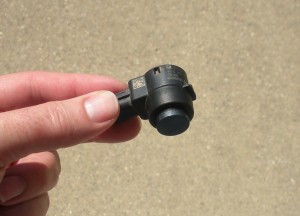
Abstract: A few years ago I worked on an ultrasonic park assist system for General Motors. We were awarded a small piece of business in early 2006. Our first modules and sensors made it into production in early 2008. Those two years were pure hell. I learned a lot about ultrasonic backup systems in those two years. My contribution was to develop all the embedded software for the control module. Our little company was eventually acquired by one of the big suppliers in mid 2008 (more stress – launching product while being taken over by a big fish at the same time.) By the end of 2008 I was totally burned out and left the automotive business. I’ve since moved on to start Powerhouse Electronics.
Since I know a thing, or two, about ultrasonic sensors and systems, I thought I would give back to the community with some insights. There are many millions of ultrasonic sensors produced each year for the vehicle manufactures. To date, I don’t see any of these sensors getting reused by the hacker community. I’m guessing this is simply due to a lack of understanding of these sensors. The automotive ultrasonic sensors would make great hobbyist’s sensors. The sensors are almost indestructible as compared to the hobbyist sensors I see used today. Below are a couple of advantages of the automotive ultrasonic sensors.
- Water Proof Design – The sensor, and connectors, are both water proof. They can even be operated underwater.
- Shock Proof – The sensors are designed to take an outrageous amount of vibration and shock. Good news if you live mounted to a vehicle fascia.
- Wide Temperatures – Operates from -40 degrees C to +80.
- EMC – Immune to susceptibility / Low radiation.
- Multi-Bus Communications – To save wire, a single communications wire interconnects all the sensors on a fascia. So, four sensors share one comm wire.
- Low Power – Sensors use less than 20mA each.
- All Digital Design – The first generation (and some aftermarket) send back the echo signal as a small analog signal. This is no good in vehicle wiring where multiple harnesses and connectors are involved. The new sensors (since early 2000′s) are all digital.
- Cooperative Operation – Sensors can be used together to achieve additional performance. As an example, to measure really small distances, one sensor pings while other sensors only listen. Note, ultrasonic sensors have a dead-time between pinging and listening (called ring-down). Knowing the fixed distance between the pinging sensor and the listening sensor(s), the distance to the object can be worked out.
- Moderate Range – The spec calls for 2.5 meter range. We suppliers struggled to achieve this given the 25mm sensor. Still, you can expect a good solid 2m range from these sensors.
My plan is to reverse engineer a competitor’s system. I’ll show the techniques involved in the process. Therefore, this will be a multi-part post with each new post digging deeper into the system. My hope is that the final post will demonstrate how to operate the sensor autonomously from the vehicle. Along the way I’ll show how to dig into the GMLAN bus system for reverse engineering purposes.
Disclaimer: All the information I’ll present here is easily available by reverse engineering existing systems. I’ll not divulge any proprietary information in these posts, so, please don’t ask.
